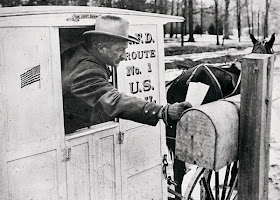I just hate it when I do my research, get my story
written and published, and then find out one of my details is historically incorrect.
I recently finished reading my second novel set in the 1800s
in which the authors referred to the U.S. Postal Service delivering mail. Oops!
That is not historically correct. In fact, novels set in more modern times may
run into trouble describing mail delivery if the author isn’t careful.
Most people use the terms POST OFFICE and POSTAL
SERVICE--with or without the U.S. in front--interchangeably. Part of the reason
is that when we go to our local building where we mail letters and parcels or
buy stamps, we call it the Post Office even though that facility is part of the
Postal Service system. Also, many of us were alive when mail service was still
part of the federal government Post Office Department.
 |
| Post Office Building, Chicago, Illinois, circa 1930s |
However, the U.S. Postal Service (USPS) did not come into existence until the passage of the Postal Reform Act in August, 1970. Yes, you read that correctly: NINETEEN seventy. The U.S. Postal Service officially started to operate as an independent non-profit corporation in 1971. Before that, it was the Post Office.
These details can be important to your writing if you
want to stay credible. For example, in my novel, Family Secrets, my main
character’s grandfather, Mike Carpenter, returned from the Vietnam War in 1968
and got a job delivering mail as a city carrier. Assuming he began work within
months of being discharged from the Army, he would have been hired by the Post
Office Department under the old Civil Service program. Years later when he
retired, he was employed by the U.S. Postal Service. Whether I describe him as
working for the Post Office or the Postal Service depends where in time I am in
the story.
What many people do not realize is that because of that
change in 1971, the Postal Service, unlike the old Post Office, does not
receive any tax revenues to operate. Those who work for the Postal Service are
still federal employees although the contracts for the different postal crafts
often have slightly different provisions than other federal employees. But, the
Postal Service is expected to operate on revenues it receives from sales and
services provided.
Another key change took place about the same time this
Act was being passed. Starting in 1969, postmasters and rural letter carriers
were no longer awarded their jobs based on political patronage. When I started
as a rural carrier, I worked with some old-timers who were proud that they
had been awarded their positions by their congressman. When I applied for the
job in 1989, I took a civil service exam and waited to be called for an
interview based on test scores, no congressman involved. In order to get my
job, I did not need to worry about whether or not I had served in the armed
forces (although veterans do get point preferences that gives them a bit of an
edge), belonged to the same political party as my congressman or met one or
more criteria that are often involved in political patronage situations.
Having a character in your story being awarded a
postmaster position due to political patronage--or not, because of political
differences--can provide an interesting plot element. Just make sure the timing
is right for this to occur.
In Family Secrets, Mike’s daughter
tells how her father likes to visit the rail museum in Old Town Sacramento. His
favorite car was the mail car. For years, the Post Office used trains to
transport mail. When his daughter was young, he would describe to her how the postal
clerks who worked in railroad cars sorted mail for the different cities similarly
to how he prepared the mail for his route.
This 1921 photo of a mail car from the USPS site I found
interesting. After numerous mail thefts on trains after World War 1, in 1921
the Post Office started having the clerks wear pistols while they worked. They
were given orders to shoot to kill any would-be thief in order to protect the
mail. Up until 1939 there were also times U.S. Marines rode the trains to
protect the mail.
Trust me, times have changed. In today’s world, if postal
employees show up at a Postal facility toting guns, they can expect to be
arrested and probably lose their jobs.
More Postal trivia:
 |
| 1888 City Carriers in New York City |
If you are writing in a historical setting, don’t have
your characters in the city receiving mail delivery before 1863. It didn’t
happen.
 |
| Early Rural Free Delivery carrier |
As for Rural Free Delivery, the very first free delivery to
folks living in the country started in 1896 as an experiment and did not become
an adopted practice until 1902.
If you are talking about addressing letters, the Post
Office started adding zones to their addresses in 1943, but Mr. ZIP did not
come along until 1963. ZIP+4 made its debut in 1983.
Last but not least, keep in mind that the Postal Service
does not accept, transport and deliver packages. They are called PARCELS.
You can also find a concise timeline on postal history at
this website: http://inventors.about.com/library/inventors/blmailustimeline.htm
For a more complete history of mail delivery in the
United States, visit the USPS website at:
Zina Abbott is the pen name used by Robyn Echols. Her novel, Family Secrets, may be purchased from Amazon, Nook and Smashwords.




